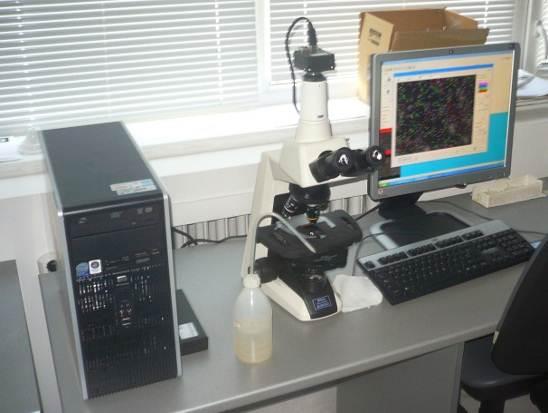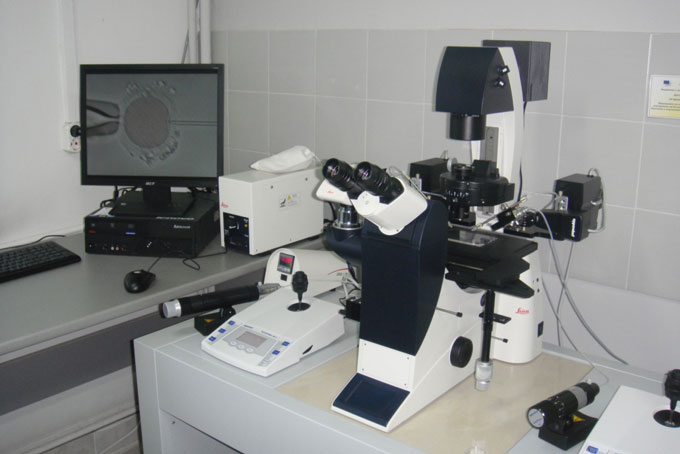Department “Embryobiotechnologies in animals”
Institute of Biology and Immunology of reproduction
Bulgarian Academy of Science
Contact
Assoc. professor D-r Rossen Stefanov, Ph.D
mob.tel.: +359 889670518
e_mail: stefanovrossen@gmail.com
Address
Institute of Biology and Immunology of reproduction,
Bulgarian Academy of Science
73 Tzarigradsko shoese
1113, Sofia, Bulgaria
tel.: (+359 2) 872 00 18
fax: (+359 2) 872 00 22
Group description
The Institute of biology and immunology of reproduction, BAS- Sofia, Bulgaria is institution for research in gamete biology and quality: sperm and oocyte metabolism, sperm motility, fertilization, egg and sperm quality; gamete cryopreservation; embriotransfer in animals. Our team consists of: 1 associate professor, 2 assistant professors and 2 PhD student. One of the assistant professors works in Laboratory of Ichthyology and Aquaculture Faculty of Biology, Sofia University, Bulgaria.
The main tools are automated sperm analyzer with software of image analyses for evaluation of sperm motility and morphology; micromanipulation system , fluorescent, confocal and electron microscopes (http://reproforce.ibir.bas.bg/en/work-package/2-Strengthening-the-technological capacity-of-IBIR-BAS). The programmer freezer and straws packaging machine freezing of gametes is shared with the National Executive Agency for selection and reproduction in animals. The outputs are in form of methodologies, technologies and research articles focused on activation, and reactivation of gametes, short and long term storage of gametes (cryopreservation). Maintained in co-operation with research institute Institute of Fisheries and Aquaculture – Plovdiv, Bulgaria.
The aim of our group is to develop biotechnologies for the biodiversity support and genetic improvement of resources. This includes cryopreservation of semen, embryo cells and tissues, as well as creating a gene bank.
Our main goals will be to standardize current techniques for fish gamete quality evaluation and to develop new protocols for lab and industry applications. To organize and implement a survey of updated aqua gamete quality assessment methods, we will compare information within the species, and with other groups of animals. We will standardize of the protocols for sperm cryopreservation and short-term sperm storage; coordinate of the tests of new cryoprotectants and development of new cryprotective mediums for storage of endangered species, aquaculture-selected or transgenic lines.
Our effort will be centered on providing a overview of the knowledge on the mechanisms responsible for the function of gametes (mitochondria function, gamete proteins, gametes oxidative stress and antioxidant protection, molecular mechanisms controlling of oocyte competence) at physiological and pathological conditions.
Relevant publications
1. Kazachka D., S. Jeleva, M. Sabev, I. Nikolov, R. Stefanov, V. Gerzilov, K. Miteva. Ultrastructural studies of spermatozoa from the species cairina moshata during cryoconservation. Comptes rendus de l‘Academie bulgare des Science. 2009, Tome 62, №3, рр.361-364, ISSN 0861-1459.
2. Stefanov. R Studies on NADH-tetrazolium reductase in ram sperm during short stock and cryopreservation. Journal Central European Agriculture 2010, 11 (4), p.481-486, ISSN 1332-9049.
3. Stefanov. R, M. Chervrnov, B. Georgiev, D. Kacheva, P. Taushanova, E. Kistanova, M. Sabev. Activity of NADH-tetrazolium reductase in bull semen after cryopreservation in relation to their motility and viability. 2012, 3rd International Scientific Meeting Days of Veterinary Medecine, Ohrid, pp.262-264.
4. Hubenova, T., E. Uzunova, D. Rozdina, P. Vasileva., 2009: Histological examination of gonad development in barbel Barbus cyclolepis Heckel from Maritza River (Bulgaria). I-st Conference on Conservation & Menagement of Balkan Freshwater Fishes (COMBAFF), Ohrid, Macedonia, 20-24.V.2009, Abstract book, 45 p.
5. G. Raikova-Petrova, D. Rozdina. 2012. Maturation and fecundity of Barbus cyclolepis Heckel from the middle stream of Maritsa River, Bulgaria. In: Proceeding Ecology – Interdisciplinary Science and Practice, part two, 569 – 575.
Institute of Fisheries and Aquaculture
Agricultural Academy of Bulgaria
Contact
Assoc.Prof. Lyudmila Nikolova, Ph.D
Phone: +359884007750
e-mail: lnn65r@abv.bg
Address:
Institute of Fisheries and Aquaculture – Plovdiv
248 Vasil Levski str., 4000 Plovdiv, Bulgaria
Group description
Institute of Fisheries and Aquaculture (IFA) of the Agricultural academy of Bulgaria is a scientific research organisation providing scientific service in the domain of the Fisheries and Aquaculture. The activities of IFA are predominantly related with the freshwater aquaculture. The research is conducted in laboratories and three experimental bases. The experimental bases of the Institute are in possession of fish ponds with total area of more than 40 ha. In the experimental bases of common carp; grass carp; silver carp; bighead carp; pike and European catfish are raised. Natural-type and artificial methods of reproduction are used. The Institute is in possession of fish hatchery complex, providing conditions for induced spawning of all the fish species raised in the bases.
The scientific activities of IFA-Plovdiv cover all aspects of the freshwater aquaculture: monitoring of the water bodies; technology; feeding; reproduction; prevention and treatment of diseases, etc.
Our group is a part of a department “Water ecology and aquaculture” and is formed by 2 Associate Professors; 3 Research Assistants; 2 Technical Assistants.
Scientific interests in the group are mainly in the area of: sustainable practices and organic fish farming; monitoring of fish ponds; fish safety and quality; fish nutrition; fish reproduction; fish welfare; fish diseases; physiology; non-specific immunology.
In close collaboration with the Institute of Fisheries and Aquaculture is the „Animal sciences” department of the Agricultural University, Plovdiv. It forms a subgroup in our team comprised of 1 Professor; 2 Associate Professors; 1 PhD student. The Department is teaching students /undergraduate, graduate and postgraduate/ in various fields of animal sciences, providing general and special courses, including inter alia aquaculture and fisheries, fish reproduction, genetic resources and specifics of the selection in fisheries, reproduction of livestock animals, animal breeding, animal hygiene, morphology, physiology, animal health and welfare, toxicology, organic livestock production. The department possesses specialized farms in the Education and experimental facilities and laboratories for education and research activities. Various studies are conducted in the area of the: selection and reproduction, animal nutrition, veterinary pathology, physiology, animal hygiene, specific and non-specific resistance, toxicology, homeostasis and metabolism in livestock animals.
Links: www.ira-plovdiv.com; www.au-plovdiv.bg
Relevant publications
1. ATANASOVA R., L. HADJINIKOLOVA, L. NIKOLOVA, 2008. Investigations in the biochemical composition of carp fish (Cyprinidae) blood serum at conditions of organic aquaculture, Bulg. J. Agric. Sci., 14(2): 117-120.
2. ATANASOVA R., L. HAJINIKOLOVA, L. NIKOLOVA, A. STOEVA, 2008. Effect of ration size upon the biochemical indices of carp fish (Cyprinidae) grown in polyculture for the needs of organic production, J. of Mountain Agric.Balkans, Vol. 11 (6): 1012-1021.
3. HADJINIKOLOVA L., L. NIKOLOVA, A. STOEVA, 2008. Comparative Investigations on the Nutritive Value of Carp Fish Meat (Cyprinidae), Grow at Organic Aquaculture Conditions, Bulg. J. Agric. Sci., 14(2): 127-132.
4. IVANOVA R., L. NIKOLOVA, H. HRISTEV, 2012. Comparative investigation of some blood indices of scaly and mirror carps reared on natural feeding. I. First summer of life. Journal of Mountain Agriculture on the Balkans, 15(1): 30-44.
5. IVANOVA R., L. NIKOLOVA, H. HRISTEV, 2012. Comparative investigation of some blood indices of scaly and mirror carps reared on natural feeding. II. Second summer of life. Journal of Mountain Agriculture on the Balkans, 15(2): 291-303.
6. NIKOLOVA L., 2010. Comparative slaughtering analysis of two-summer old silver carp (Hypophthalmichthys molitrix Val.) reared under the conditions of integrated and non-integrated technologies, Journal of Central Europian Agriculture, 11(2): 173 – 174.
7. NIKOLOVA L., G. GROZEV, K. DOCHIN, 2005. The effect of some paratype factors on the growth of bighead carp (A. nobilis) reared in polyculture, Journal of Environmental Protection and Ecology, Official Journal of the Balkan Environmental Association, 6(2): 454-461.
8. NIKOLOVA L., K.T. DOCHIN, G.К.GROZEV, E.I.PASKALEVA, 2008. Influence of the Vegetation of the Plankton on the Growth of the Bighead Carp While Being Bred in Autochthonous Polyculture Along with Common Carp and Grass Carp, Acta Zool. Bulg. Suppl. 2: 193-200.
9. NIKOLOVA L., L. HADJINIKOLOVA, A. STOEVA, 2006. Slaughtering Analysis of Three-Year Old Carp (Cyprinus carpio L.) Reared under the Conditions of Integrated and Non-integrated Technologies, Bulg. J. Agric. Sci., 12: 343-351.
10. NIKOLOVA L., L. HADJINIKOLOVA, K. DOCHIN, D. TERZIYSKI, R. ATANASOVA, А. STOEVA, G. GROZEV, E. PASKALEVA, 2008. Carp Fish Rearing In Autochthonous Polyculture of One And The Same Age (Cyprinus carpio L., Aristichthys nobilis Rich. and Ctenopharyngodon iddela Val.), Bulg. J. Agric. Sci., 14(2): 133-138.
11. NIKOLOVA L., L. HADJINIKOLOVA, K. DOCHIN, D. TERZIYSKI, R. ATANASOVA, А. STOEVA, G. GROZEV, E. PASKALEVA, 2008. Carp Fish Rearing in Autochthonous Mixed Polyculture (Cyprinus carpio, L., Aristichthys nobilis Rich. and Ctenopharyngodon iddela Val.), Bulg. J. Agric. Sci., 14(2): 139-144.


